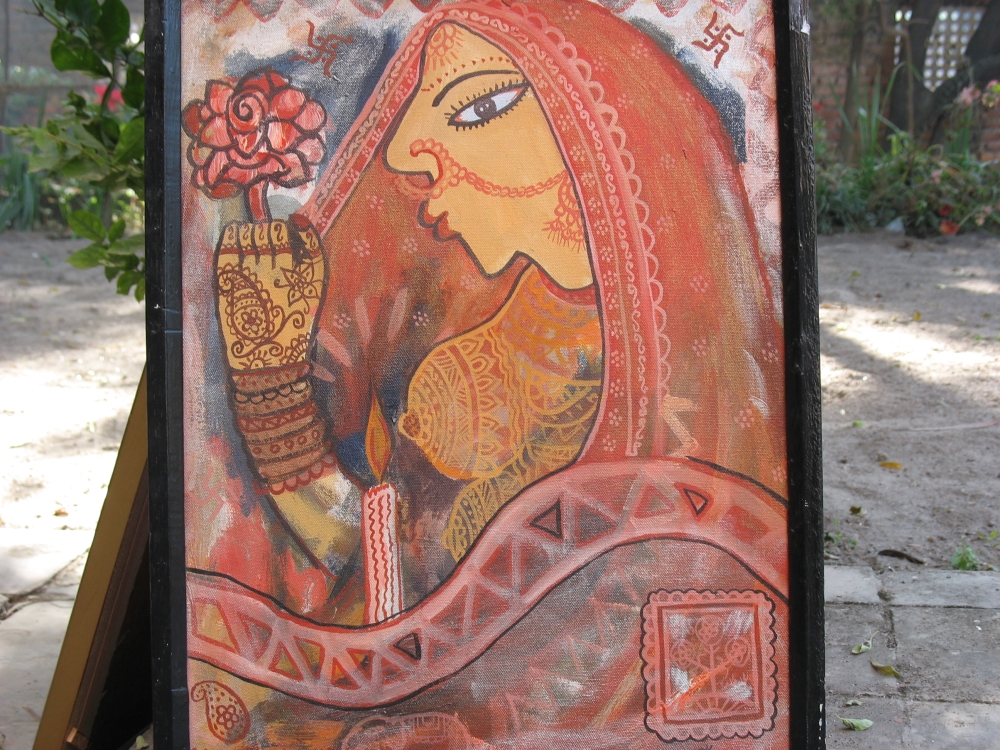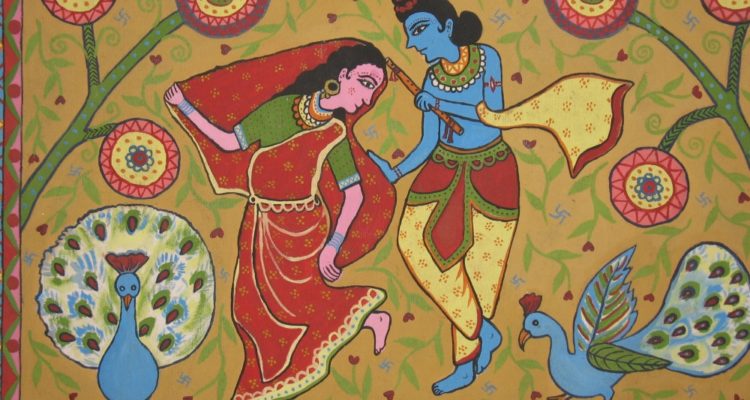Shyam Sundar Yadav, art curator and executive director of Mithila Yain Art Gallery, is a popular Mithila Artist. He hails from Siraha where Mithila art decorates every house. And, he had an innate talent in art. He has done ample research in Mithila Art and brought modern concepts in the field. His first conceptual art was ‘Grihalaxmi’ which was inspired by women who were referred to as ‘lakshiniya’ in his village, who used to do all the household chores from morning till night. That painting won National Award and now sits with glory in the President’s House. Since then he started doing fusion art.
His paintings voice women’s strength, such that a woman is capable of doing all the things a man does, like plowing the field, driving, and many others. Those conceptual arts have gained popularity and people have appreciated the change they found in his art. This article holds a conversation with the artist himself to know more about him and Mithila art.
How did the Mithila Yain Art Gallery come to life? What’s the inspiration behind it?
After my SLC, I continued my studies in art at Lalit Kala Campus. But to not let fine art dominate the folk art, I returned to my village to do research about Mithila Art. I spent about five years to learn how Mithila Art is painted, why it is painted on walls and bodies; I wanted a complete detail on its concept. Then, I went to every village in Siraha, Dhanusa, Mahottari, Sarlahi, Saptari, and Sunsari along with some places in India for my research purpose.
At those times, we didn’t have a proper market where our hard work would get recognition. I have gone to the streets to sell my paintings. I even sold my work at Rs. 600 only. Mithila art wasn’t well appreciated at that time; there were almost no sales of Mithila Art in the market. Then I thought of having my own gallery, a friend of mine lent me this place, hence here it stands as Mithila Yain Art Gallery since 2062.
How does the Mithila Yain Art Gallery promote and encourage artists?
We organize various exchange programs between countries like we would do our exhibitions in India, and Indian artists would do theirs here. And there is a lot of national and international artists’ inclination towards us. We have organized exchange art exhibitions like Nepal-Indonesia, Nepal-Korea, Nepal-Bangladesh to name a few. This makes their art, and the artist themselves recognized in various parts of the world. Now, there is no such shop in Thamel which doesn’t have a Mithila painting, which is a product of this gallery. The art which was on the verge of extinction now has a proper market and is well-recognized now. And our artists too, feel content because of it.
How does the gallery operate? Is there any model for profit-making, or is it for service
purposes only?
I never started this gallery for a commercial purpose; I did it more for the development of art and service. And with it, my paintings got its customers time and again. After that, I decided to hold exhibitions. I take no hall charge with the artists for the exhibition instead, I asked for 30% of what the artist makes with the sale of each painting. I am an artist too, it is not hard for me to earn now. As I have given all my time to this gallery, I can work well, enough to operate it.

Photo courtesy: Shyam Sundar Yadav
How important do you think are art exhibitions? How do such exhibitions increase art value or networking?
We all work in our respective fields and do our job. But it is only when the work comes upfront, we notice who is behind it. Just like having a degree in your house is useless, if you stay at home and don’t work. An artist’s work is appreciated only when his arts are displayed, only then he and his work get identity. An artist always goes through a learning process. Those who are proficient hold solo exhibitions, while those who are still learning find their way in group exhibitions.
The concept of our gallery while holding exhibitions is to promote the artist’s work and also it’s a great opportunity to encourage sales. When we hold exhibitions, even a child, society, the general public gets to witness our art and learn about it. It strikes conversations relating to art among societies, the whole country and finally, it reaches the international societies too. In this way, people who never knew about our art get to know about it. And if they are interested to buy it, the artists make good money.
In India and China, there is a huge market for art, an artist sells his painting up to 1 crore as well. Nepal’s market value situation is highly different than that, our paintings hardly get a decent price. You may want to know why; it is not because of the absence of creativity or beauty in the paintings. It is because of the lack of promotion, advertising, and proper publicity. Our paintings in foreign lands get higher prices than they do here.
Like Mithila art, there are a lot grass root level/ underrated arts and artists. How can we connect with them to bring them forward?
We lack galleries that would look for and encourage art. Nepali artists do not get to feel that they can do something big here. I look for such artists who are extremely talented in what they do but are always behind the curtains. Even now, I am searching for good artists who are not well-received and acknowledged. All so, that we can work together and make them well known in the Nepali Art market. I am planning to have another exhibition with them, in the coming month.
Apart from the gallery exhibitions, what else can we do to increase an artist’s product value?
There are a lot of things that can be done, but it mostly depends on the hands of a writer. If a writer or a critic writes about the art and discusses the good in it and the bad in it, it reaches a huge mass. Just like you are interviewing me right now, if a reviewer writes more about art, maybe write a book too on it, it will grab the attention of the public and will stir discussions among them.

Photo courtesy: Shyam Sundar Yadav
Where do you see the Nepali art scenario progressing? What are the scopes of it?
Progress in Nepali art has been constantly growing, it may be a small growth but it is growing. Previously, we rarely heard about exhibitions, maybe once in a while. Nowadays, there are exhibitions happening every other week. But only the workshops and exhibitions aren’t really enough to improve the Nepali art scenario, we need to establish a proper market in Nepal.
Parents invest almost crores in their child’s education who is pursuing medicine; it is because they know there is good income and a stable future behind that. But, even today, no father would do so in the case of art, it is because there is no market for a good or stable return, currently.

Photo courtesy: Shyam Sundar Yadav
What can we do to improve the situation of art including Mithila art? Are there any suggestions that you would like to give?
There are three factors we can improve in: artist, art organization and writer. Till these three factors come together in a line, change is not possible. If the writers look for real beauty in the art and give a chance to the talented artists who are not famous, the status of Nepali will highly improve. The art galleries too should look for new talents and help them show their creations to the world.
Also, if Nepal Government supports our work, organizes art exhibitions and establishes art museums, it will help to raise discussions on art and will make a huge difference. There are no art galleries outside Kathmandu and Pokhara, in our country. If we worked in these areas, our art would flourish.
The government doesn’t even need to invest much to develop art if they only ask every household to compulsorily have at least one painting; the condition of our artists would improve. This would make every home in our country, a museum. A glance at a painting relaxes a stressed mind, thus it benefits both the artist and the customer.
Also, if our government and art academies also invest to uplift the status of our Nepali artists it will decrease the number of artists, who are compelled to leave the art sector because their arts are not properly valued. The government has the power to bring out this change. But we all have to work together for Nepali art and artists to thrive.



Leave a Reply
You must be logged in to post a comment.